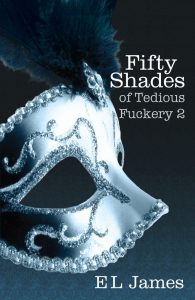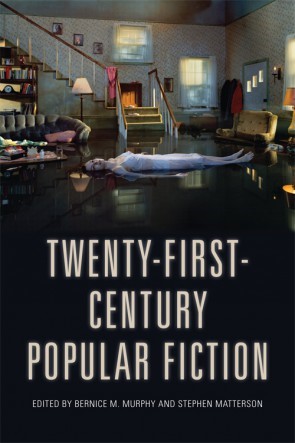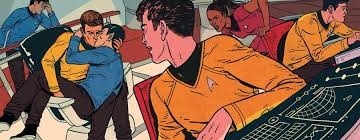
Fifty Shades of Grey is boring. Charting the development of a deeply unequal relationship between a broke, sexually inexperienced English Literature graduate and a slightly older billionaire – a seasoned “dominant” who “like[s] to whip little brown-haired girls” (Fifty Shades Darker) for his own sexual pleasure – E.L. James’[1] trilogy and the resulting film versions explore the inner thoughts of this ill-matched pair in such detail that little or no room is left for plot. I recently watched the 2015 film version of the first book (Fifty Shades of Grey [2011]) and realised after about half an hour that I had crept closer to the television in the vague hope that this would somehow make it go by more quickly.
I found myself in this less-than-pleasant situation after reading the first book several years ago, for the purposes of teaching it to a group of Masters students. While I will fully admit that I rather enjoyed sitting on the bus annotating it with a red pen, I still cite the final sixty pages as the slowest of my life. I had simply ceased to care about Anastasia Steele and whether or not she was prepared to let Christian Grey “punish” her for minor infractions of the list of rules (he actually prints it out and makes her sign it) that he sets out for his “submissive” female partners, or if she might manage to “fix” him so that he could become proper boyfriend material. In fact, she sort of does both, and I therefore remain rather confused as to what the books are trying to say about men, women, heterosexual relationships, or anything else.

Is spanking harmless sexual fun that women should learn to enjoy, or is it an act of gender-inflected power and subjection to be trained out of men by “good” women who refuse to be drawn into their web of entitlement? Is Christian really serious when he flies into a temper at Ana’s lip-biting and eye-rolling, or is this all part of the elaborate role-playing scenario he establishes? Does she actually like him at all, or does she just like the idea of saving a troubled rich guy with a dark past? Raising questions like these is, I’ve slowly come to understand, potentially the point of the books. Nonetheless, considering the problematic nature of Christian and Ana’s relationship, in which he is all-powerful, controlling, suspicious, manipulative and inflexible, and she must effectively pander to his bewildering mood swings, I suspect that the difficulty I find in answering them may be behind much of the (often articulate and fully justified, occasionally hilarious) outrage and derision in articles, blogs, and satires that the books and films have inspired. Whether I am part of this scoffing, tut-tutting horde of detractors is, I must admit, by no means clear to me; I do, however, certainly share a general sense that the books’ conceptual muddiness regarding the interaction between sex and violence is A Bad Thing.

I’ve now seen both films, and read all four books (including the excruciating Grey [2015], the first book retold from Christian’s point of view, in which he manages to objectify Ana and his own genitalia equally – her very voice “echoes through [him] – to the end of [his] cock,” apparently making his “jeans even tighter”), and I am none the wiser as to their “message,” nor has the boredom abated much. The sequels (Fifty Shades Darker and Fifty Shades Freed – both 2012) do throw in some kidnappings and helicopter crashes in an attempt to spice things up a bit. However, they remain little more than washed-out (grey?) shadows of Stephanie Meyer’s Twilight saga (2006-08), to which the first book (originally entitled Master of the Universe (c.2010), under the pseudonym Snowqueens Icedragon) was originally a fanfiction tribute, with the supernatural elements removed.
So why, you might very reasonably ask, am I now writing a blog post on the phenomenon, having already taught a two-hour class on it (full of several outraged women and two very embarrassed young men), written an article on it for a new collection entitled Twenty-First Century Popular Fiction (edited by Bernice M. Murphy and Stephen Matterson [Edinburgh University Press, 2018]), and recently delivered a public lecture on it? I sometimes ask myself the same thing, but I suspect that the answer is relatively straightforward: consuming various Fifty Shades products might be (for me) a somewhat wearisome task, but thinking about it is fascinating. It’s an especially useful flash point, I’ve found, for discussing issues around current writing trends (particularly writing for, by, and about women), popular culture (particularly contemporary popular fiction and reading habits), and our society’s attitudes towards heterosexual relationships and gender difference.

Arguably, what is more interesting about the Fifty Shades phenomenon is its relationship to fanfiction, a community and a form of writing (and readership) to which James’ books drew an unprecedented degree of mainstream public attention. Fanfiction is writing that appropriates characters and settings from pre-existing texts (such as, say, Star Trek and other long-running TV shows like Supernatural [2005-present], though films and books like the Harry Potter series are also used), and re-imagines them as participating in various scenarios (often romantic and sexual pairings) that do not occur in the original. Well-known pairings in this kind of writing (known as “slash fiction”) include Spock/Kirk, Harry/Malfoy, and Buffy/Faith, Angel/Spike, or even Xander/Spike in Buffy the Vampire Slayer (1997-2001). In the process, such fiction, generally published online without the intervention of a conventional publishing company, contains the potential to subvert the ways in which relationships and hierarchies are structured in the original or “canon” material.[2] Many writers of fanfiction set out to “correct” what they see as wrong-headed or unsatisfying couplings among characters, but are also frequently driven by a desire to push against the rigidly heterosexual, racially and economically segregated world of popular culture. This was very much a niche activity and readership for many years, but, while it may not be half as radical as much fanfiction, nonetheless, the popularity of the Fifty Shades phenomenon has rendered such forms of writing more familiar to “mainstream” audiences.



However, fanfiction wasn’t the only underground cultural habit that the trilogy dragged into the light of day – it also meant that far more people suddenly knew what BDSM stands for (Bondage and Discipline, Dominance and Submission, and Sadism and Masochism), and arguably, all of this was made possible by the fact that sales of the Fifty Shades books were boosted by the newly booming e-reader market. As Bridget Kies has pointed out, readers were enabled by devices like the Kindle to read “racy” books without the covers advertising the fact to the general populace. She also notes that a similar secrecy surrounds participation in fandom, and she therefore sees the Fifty Shades phenomenon as producing or at least marking a watershed moment, bringing both BDSM and fanfiction to the attention of the mainstream media and of readership whose members might normally never have been caught dead reading anything so “out there”.[3]
Nonetheless, the books are noteworthy for their rather uneasy attitude towards their own fanfiction origins. Since their hard-copy publication by Vintage, all previous online versions have been taken down, including from the archiving service the Wayback Machine. This was done for copyright reasons, which seems to have been particularly necessary in light of the fact that there are some issues regarding the final versions’ exact status. A website called Dear Author apparently ran the book through the anti-plagiarism software Turnitin in March 2012, and, while Vintage claimed that Fifty Shades was an original piece of writing, the match between the original online fan fiction, Master of the Universe, and the final printed copy was 89%.[4]
A certain degree of self-plagiarism is perhaps forgivable, especially considering that the original fanfiction had been so popular. Rather less savoury, however, has been the books’ ongoing relationship with the community of fanfiction writers and readers that made James’ success possible in the first place. As Kies notes, James’ publishers have attempted to prevent fans from doing to Fifty Shades what James herself did to Twilight, and “fans authoring fan fiction about Fifty Shades have received warning letters from publishers about potential copyright infringement, despite the fact that these fans were participating in the same kind of paratext creation that Snowqueens Icedragon initially was.”[5] This treatment of fans is particularly disappointing considering the collaborative, mutually supportive nature of many fanfiction communities. For Kies, “[b]y creating work for each other, engaging with each other’s work and offering feedback, fans solidify social bonds and forge group identities,” in ways that she sees as actively resisting the competitive, patriarchal practices of the publishing industry.[6]
James’ actions (or rather those of Vintage, who picked up the series after it had initially been published by a virtual publisher, The Writer’s Coffee Shop) are not without precedent, though. The process of disentangling a piece of writing from its fanfiction origins is, according to Abigail de Kostik, called “filing off the serial numbers” and “pulling to publish”. As she notes, “many fans have objected to what they perceive as individual fans’ exploitation of communal, collaborative scenes of fiction production for private gain.”[7] Consequently, she writes, “[w]hen James erased her fan fiction from online fan archives, she deleted a part of the cultural heritage of her fellow fans to the detriment of their community, and she denied the explicitly communal nature of the authorship of her work.”[8]
The derision with which Fifty Shades has been met should therefore, I think, be understood within this context. The series’ content may be deeply troubling, and its treatment of Ana and Christian’s relationship is anything but feminist; however, the books themselves have participated in, rejected, but also drawn attention to female-led, communally supportive forms of writing. What is more, genres or movements like fanfiction and, before that, romance novels such as the “Mills and Boon” imprint, arguably privilege narrative pleasure and readerly satisfaction over “deeper” themes or ideas, and therefore stand in direct opposition to the Romantic image of the lone male writer struggling with his inner demons in order to produce original art from the depths of his isolated imagination.[9] While the books might seek to disavow their supposedly humble roots, and while I myself might find reading them somewhat painful, it’s nonetheless important to acknowledge their contribution to promoting what might be considered to be a “feminine” form of writing and production (however problematic or potentially essentialising such labels might be). As Tania Modleski put it over thirty years ago, “countless critics […] persist in equating femininity, consumption, and reading, on the one hand, and masculinity, production, and writing on the other.”[10] Richard McCullogh argues that many of the series’ loudest detractors in fact criticise the books for precisely their association with “feminine” forms of writing and consumption of popular-culture products, such as “Pottery Barn, Marks & Spencer and Downton Abbey,” and “Mills & Boon, daytime soap operas, and female audiences,” associations which “position the film [and books] as ‘lowbrow.”’[11]

Such assessments dismiss Fifty Shades as anti-intellectual fluff that only women could possibly enjoy, let alone write, and that must be dreadful and utterly worthless because it’s been written in a genre associated with women readers and writers. What is potentially ironic about these sneering condemnations is the fact that the books are, at heart, nothing less than the most recent iteration of a plot that is, in effect, the most basic plot that Western culture (popular or otherwise) repeatedly tells itself about love, marriage, and the relationship between sex, marriage, and money. Narratives in which a young, virginal girl is swept up in a love affair with an older, dangerous man are in many ways a sort of origin myth about heterosexual, middle-class gender relations, one that is evident in “canonical” or “highbrow” and “popular” romance fiction alike. I might find the books and films boring and misogynistic, but intellectually I was very excited when I realised how closely they align with another very boring, potentially equally misogynistic book, Samuel Richardson’s Pamela (1740). Pamela is, I would argue, a sort of basic marriage-plot template, and reading it has really helped me grasp how so many courtship novels, romantic comedies, and (believe it or not) horror films about crazed murderers are structured and conceived. I could write at length about the many ways in which the Fifty Shades books and films chime in with everything from “Cinderella” and “Beauty and the Beast,” through Jane Austen’s Pride and Prejudice (1813) and Daphne Du Maurier’s Rebecca (1938), right up to The Sound of Music (1965) and Save the Last Dance (2001) (which have a lot more in common than you might think), not to mention slasher films like Halloween (1978) and Friday the 13th (1980).
But all of that, I suspect, is a blog post for another day.
____________________________________________
Works Cited
de Kosnik, Abigail. “Fifty Shades and the Archive of Women’s Culture”, Cinema Journal, 54:3 (Spring 2015): 116-125.
Jones, Bethan. “Fifty Shades of Exploitation: Fan Labor and Fifty Shades of Grey,” Transformative Works and Cultures, 15 (2014), n.p., <http://journal.transformativeworks.org/index.php/twc/article/view/501/422> (last accessed 31 March 2016).
Kies, Bridget. “A Red Room of Her Own: Dominants, Submissives, Fans, and Producers of Fifty Shades of Grey,” Intensities: The Journal of Cult Media, 8 (Jan 2016): 34-43
McCulloch, Richard. “Tied Up in Knots: Irony, Ambiguity, and the ‘Difficult’ Pleasures of Fifty Shades of Grey,” Intensities: The Journal of Cult Media, 8 (Jan 2016): 1-19
Modleski, Tania. Feminism Without Women: Culture and Criticism in a “Postfeminist” Age (New York and London: Routledge, 1991).
_________, Loving With a Vengeance: Mass-Produced Fantasies for Women (New York: and London: Methuen, 1982).
Radway, Janice, Reading the Romance: Women, Patriarchy, and Popular Literature (Chapel Hill: University of North Caroline Press, 1991).
[1] “E.L. James” is the pseudonym used by writer Erika Mitchell.
[2] de Kosnik, p.117.
[3] Kies, p.42.
[4] Jones, Section 3.
[5] Kies, p.37.
[6] Kies, p.36.
[7] de Kosnik, p.120.
[8] de Kosnik, p.123.
[9] See Modleski (1982) and Radway for a more detailed discussion of these issues.
[10] Modleski (1991), p.26.
[11] McCulloch, p.4 and p.12.
Bio:
Dara Downey is a visiting lecturer in the School of English, Trinity College Dublin, and the Trinity Access Programme. She is editor of The Irish Gothic Journal and Vice Chair of the Irish Association for American Studies. She is author of American Women’s Ghost Stories in the Guilded Age (Palgrave, 2014), and co-editor of Landscapes of Liminality: Between Space and Place (with Ian Kinane and Elizabeth Parker, Rowman and Littlefield, 2016). She is currently working on a monograph on servants and slaves in American gothic. She blogs at https://iknowwhatiwatchedlastsummer.wordpress.com/.
